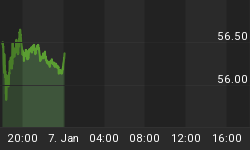It's been a crazy month. So much drama and so much uncertainty ... it all left investors somewhat shell shocked.
Shake, Rattle & Roll
With the Fed stating that it'll wait before cutting back on its quantitative easing (QE), it again rattled investors, raising many questions...
Memories of 2007-08 resurfaced. As you'll remember, the credit bubble burst, resulting in the collapse of Lehman Brothers and a severe crisis, which took the economy to the brink of a depression.
So yes, investors are nervous, and with reason...
While showing some improvement, the economy is barely scraping along and all the Fed's efforts haven't done much.
Over the past year, economic growth has been the slowest ever recorded, except for when recessions were in force.
One important reason why is because banks aren't lending , despite the Fed's easy money. As you can see on Chart 1 below, loan growth has been anemic compared to what it was at the end of previous recessions.

Instead, banks have built up their excess reserves at an astounding rate, from zero in 2008 to $2 trillion in 2013!
In turn, this has resulted in an ongoing decline in the velocity of money (see Chart 2 below).

Basically, this means that money isn't changing hands, which is not a good sign because the velocity measures the demand for money. This is deflationary.
Some Good News
On a brighter note and thanks to the Fed, we're seeing some positive signs in the markets. The stock market, for instance, has been on the rise, telling us that better times lie ahead.
Interestingly, gold and bonds are telling us the same thing and we'd be foolish not to listen (see Chart 3A).

Gold Better Than Bonds
This chart is so important we really want you to take a hard look at what it's telling us.
Very simply, this ratio chart compares gold to bonds. When it rises, gold is stronger than bonds. And when it declines, gold is weaker than bonds.
We call this our inflation-deflation barometer. Why?
Gold tends to rise during inflationary or generally good economic times. That's why the ratio's been rising over the past decade.
The two exceptions were in 2008 and 2011, which were periods of recession and slow growth. In both cases, the ratio declined because gold was weaker than bonds.
In other words, bonds usually outperform gold when the economy is weak and/or deflationary forces are more dominant.
This has clearly been the case over the past couple of years with the economy on thin ice.
So where do we currently stand? We're happy to report the ratio is again on the rise. Plus, the ratio's leading indicator has surged higher, signaling the ratio is going to rise further.
A Sign Of Better Times Ahead
This means the deflationary forces we've been living with in recent years are going to be left in the past.
It's telling us the economy is going to improve, probably fueling some inflation, which at this point would be a welcome relief.
And of course it means that gold is going to be stronger than bonds.
Inflation On The Horizon
Many people haven't noticed but producer prices have been creeping up over the past three months. Whether or not this marks a change to higher inflation remains to be seen but our inflation-deflation barometer suggests that it could.
Keep in mind, the potential for higher inflation is well in place. Bank reserves are massive and normally, banks only keep about 10% of their money in reserve.
So once banks start lending, inflation could pick up quickly as money moves out of the banks and into the economy.
More Bubbles Upcoming
Like the tech bubble and the real estate bubble before this, the Fed has essentially created yet another bubble.
We'll soon see how this unfolds but the markets are giving us a sneak preview. And unless we're reading it wrong, we should be in for some real changes. Stay tuned.















